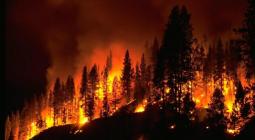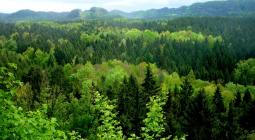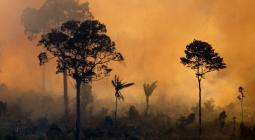Fiercer, more frequent fires may reduce carbon capture by forests.

Global study shows blazes diminish forest density and tree size, making woods likely to sequester less carbon.
More fierce and frequent fires are reducing forest density and tree size and may damage forests’ ability to capture carbon in the future, according to a global study.
Although forest fires are naturally occurring phenomena and natural forests regenerate, global heating and human activity have caused the frequency and intensity of fires to rise. Wildfires burn 5% of the planet’s surface every year, releasing carbon dioxide into the atmosphere equivalent to a fifth of our annual fossil fuel emissions.
Researchers analysing decades of data from 29 regions in Africa, Australia, North America and South America have found that sites that had fires every year had 63% fewer individual trees and 72% less basal area – a measurement which reveals the trees are much smaller – than places that never burned. Landscapes with fewer, smaller trees are likely to sequester less carbon.
There is growing interest in planting trees as a natural climate solution, with the Trillion Trees campaign attracting the support of the global politicians and business leaders and even the enthusiastic backing of Donald Trump in the final year of his US presidency.
But researchers warned that afforestation efforts to sequester carbon would have to choose planting locations carefully and take heed of changes to fire frequency, with regular blazes changing the species within wooded areas as well as tree size.
“Planting trees in areas where trees grow rapidly is widely promoted as a way to mitigate climate change. But to be sustainable, plans must consider the possibility of changes in fire frequency and intensity over the longer term,” said Dr Adam Pellegrini of the University of Cambridge, who is first author of the paper.
“If you plant trees that are not adapted for fire, those forests may sequester carbon for 20 or 30 years but you have to ask yourself how stable is that carbon?”
The study, published in Nature Ecology and Evolution, found that savannah ecosystems and tropical regions with more extreme wet and dry seasons were the most sensitive to changes in fire frequency. In tropical areas, grass grows more vigorously in the wet season before drying out and burning more intensely in the dry season, with hotter and more frequent fires hindering the ability of some trees to recover from the fire.
“Our study shows that although wetter regions are better for tree growth, they’re also more vulnerable to fire,” said Pellegrini. “That will influence the areas we should manage to try and mitigate climate change.”
The tropics is the favoured area for climate-motivated afforestation because fast-growing, dense natural tropical forests sequester more carbon than temperate woodlands.
Previous studies have shown how frequent fires reduce the levels of nutrients such as nitrogen in the soil. The new research shows that this can favour slower-growing tree species that can thrive with fewer nutrients. But these trees may limit the recovery of the wider forest by retaining nutrients rather than moving them into the soil where they can be used by other species.
“As fire frequency and intensity increases because of climate change, the structure and functioning of forest ecosystems are going to change in so many ways because of changes in tree composition,” said Pellegrini. “More fire-tolerant tree species are generally slower growing, reducing the productivity of the forest.”
In the past, the majority of carbon released by wildfires was recaptured, as ecosystems regenerated, but more frequent or intense fires do not allow for such natural recovery.
Fire cycles are a positive and necessary part of some landscapes, however, ensuring a diversity of plants and animals. If fires are suppressed by people in savannah systems, the species-rich grassland can be rapidly covered by a less diverse treescape.
The research effort, a collaboration with the managers of 374 forest plots across four continents where experimental burning was carried out or prevented, will next examine the impact of fires and their frequency on biodiversity.
25 February 2021
The Guardian







